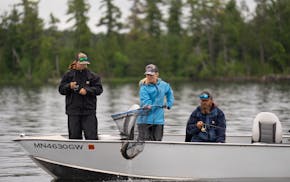If the invasive buckthorn that is strangling the life out of Minnesota's forest floor has a weakness, it is right now, in the shortening daylight of the late fall.
With a little help and planning, certain native plants have the best chance of beating back buckthorn and helping to eradicate it from the woods, according to new research from the University of Minnesota.
The sprawling bush has been one of the most formidable invasive species to take root in Minnesota since it was brought from Europe in the mid-1800s. It was prized as an ornamental privacy hedge. All the attributes that make buckthorn good at that job — dense thick leaves that stay late into the fall, toughness and resilience to damage and pruning, unappealing taste to wildlife and herbivores — have allowed it to thrive in the wild.
Buckthorn grows fast and thick, out-competing the vast majority of native plants and shrubs for sunlight and then starving them under its shade. It creates damaging feedback loops, providing ideal habitat and calcium-rich food for invasive earthworms, which in turn kill off and uproot native plants. That leaves even less competition for buckthorn to take root, said Mike Schuster, a researcher for the U's Department of Forest Resources.
When it takes over a natural area, buckthorn creates a "green desert," Schuster said. "All that's left is just a perpetual hedge, with little biodiversity."
Since the 1990s, when the spread became impossible to ignore, Minnesota foresters, park managers and cities have spent millions of dollars a year trying to beat it back. They've used chain saws and trimmers, poisons and herbicides, and even goats for hire. The buckthorn almost always grows back within a few years.
It's been so pervasive that a conventional wisdom formed that buckthorn seeds could survive dormant in the soil for up to six years. That thought has led to a sort of fatalism: Even if the plant were entirely removed from a property, there would be a looming threat that it would sprout back, Schuster said.
But there is nothing special about buckthorn seeds. They only survive for a year or two.
Buckthorn's main advantage — its superpower in Minnesota's forests — is that it keeps its leaves late into the fall, Schuster said.
When the tall thick mature buckthorn stems and branches are cut down or lopped off, young sprouts shoot up. Those sprouts put a great deal of their energy into keeping those leaves.
That's how buckthorn gathers "critical resources for its growth and survival in the winter and summer," Schuster said. "It needs that light in the late fall."
And that's where the opportunity is to beat it.
Schuster and the university have studied buckthorn in infested forests and parks throughout the state for the past several years in a project funded by state lottery profits that are set aside for Minnesota's Environmental and Natural Resources Trust Fund. Voters will decide on Tuesday whether to extend a constitutional amendment to continue funding the trust with lottery profits.
The researchers have published their findings in several journals, most recently in Biological Invasions, and produced a guide to help foresters and park managers. They found that after cutting down the main stems of a buckthorn hedge, they can keep it from growing back by immediately spreading seeds of certain native plants that can literally stand up to young buckthorn, shading it out, in those first two critical autumns.
One of the best is Virginia wildrye, a native grass that is cheap and grows quickly and densely, the researchers found.
"It's a race against time," Schuster said. "We're seeing that if you can grow and quickly establish this thatchy layer of grasses, it shades it out right when buckthorn is in most need of light."
The problem with grasses is they need a lot of sunlight. They can typically only take root in thinner forests where the canopy has at least some open sky — on ground where if you were to look straight up, at least 10% what you would see was blue.
In thicker woods, shade-tolerant wildflowers, such as large-leaved aster, white snakeroot and beebalm, can help. As can native woody shrubs like elderberry. But those can be much more costly than grasses to plant and can sometimes take too long to establish, Schuster said.
Native plants alone won't eradicate buckthorn once it's established. It first needs to be cut down or treated with an herbicide. But when planted in the right densities, the native grasses and shrubs can be the most effective way to keep the bush from returning, Schuster said.

Why now might be the best time to make a deal on boats, ATVs and other powersports
Lupine is starting to bloom in Minnesota. Here's where to find it.

Xcel lets loose a small army of hungry sheep to keep its solar farm in order

Anderson: In early June, Minnesota fish are begging to be caught. Won't you help?
